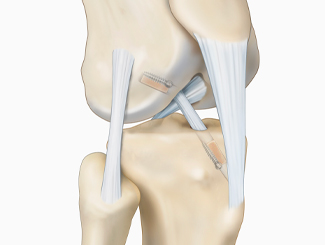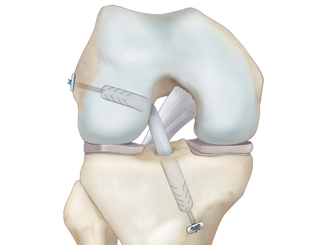ACL Reconstruction
ACL reconstruction involves the replacement of the ruptured (torn) ligament with a tendon graft. Graft tissue is either taken from the patient (autograft) or from a tissue donor (allograft).
The source of the graft tissue and the technique depend on the severity of the injury, age, activity level of the patient, the desired outcome, and knee surgeon Dr. Chahla’s preferred method. Each type of graft has its advantages and disadvantages, and it is important that you discuss any questions you may have with Dr. Chahla during your appointment as you choose from the graft options below:

Bone-patellar tendon-bone (BTB) autograft ACL reconstruction has the longest proven track record of successful outcomes and is the technique to which all others are compared. In general, autografts have better long-term outcomes and a lower risk of complications compared to other graft types. The BTB Autograft, in particular, is the gold standard graft choice for ACL reconstructions of young, active patients because of its strong bone-to-bone fixation properties. The BTB autograft is harvested from the central third of the patient’s patellar tendon, along with bone plugs from the patella (kneecap) and tibia.

BTB Allografts are grafts sourced from a donor (cadaver). They are processed and preserved by tissue banks and can be readily available for surgery. The main advantage of allografts is that they avoid the need to harvest tissue from the patient’s own body, reducing additional surgical sites and potential donor site morbidity. However, there is a slightly higher risk of graft failure, though the risk is still relatively low. These are often times a good graft selection for middle-aged or older individuals who are not planning to return to sports/activities that lead to excessive strain on the ACL (pivoting, cutting, rapid change in speed/direction, etc.)
More recently, the quadriceps tendon autograft has gained popularity as a graft source for ACL reconstruction; however, further data is necessary for a more widespread use. This graft is harvested from the patient’s quadriceps tendon, with or without bone plugs from the patella. This is typically the graft of choice when performing an ACL reconstruction on a pediatric patient whose growth plates remain open (ACL Reconstruction using Physeal-Sparing Technique). Open physes are an x-ray finding that knee surgeon Dr. Chahla will bring to your attention during your consultation should your images reveal this.

In this technique, the semitendinosus and gracilis hamstring tendons are harvested from the patient’s own hamstring muscle. The hamstring tendon autograft is considered less invasive than the patellar tendon autograft. However, the re-tear rate associated with hamstring tendon autografts is higher compared to other graft choices. Additionally, the hamstring tendons act as a secondary stabilizer to the knee joint. For this reason, knee surgeon Dr. Chahla does not typically recommend the hamstring tendon autograft to patients undergoing ACL reconstruction.
The anterior cruciate ligament (ACL) is a critical stabilizer of the knee, and an ACL tear can cause significant instability, pain, and difficulty with movement, particularly in athletes and active individuals. ACL reconstruction is a surgical procedure designed to restore knee stability by replacing the damaged ligament with a graft, typically using tissue from the patient’s own body or a donor. Dr. Jorge Chahla, a board-certified orthopedic knee surgeon, specializes in minimally invasive ACL reconstruction techniques to ensure optimal recovery and long-term knee function. If you have suffered an ACL tear and are looking for expert care, schedule a consultation with Dr. Chahla in Chicago, Naperville, or Oak Brook to discuss your treatment options.
At a Glance
Dr. Jorge Chahla
- Triple fellowship-trained sports medicine surgeon
- Performs over 800 surgeries per year
- Associate professor of orthopedic surgery at Rush University
- Learn more



